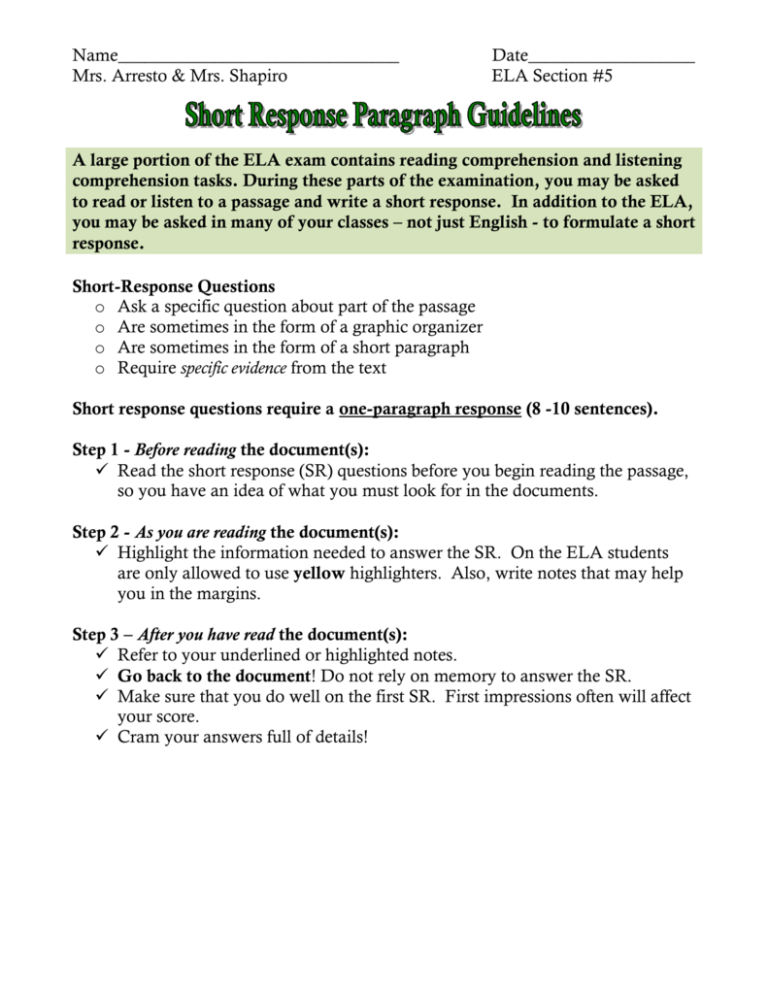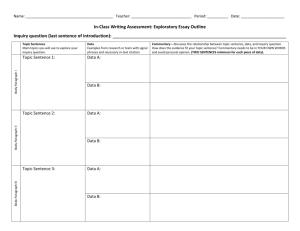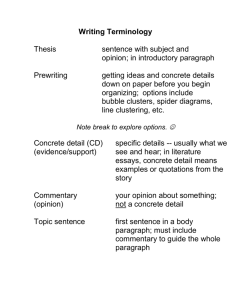Short response questions require a one paragraph response (5
advertisement

Name________________________________ Mrs. Arresto & Mrs. Shapiro Date___________________ ELA Section #5 A large portion of the ELA exam contains reading comprehension and listening comprehension tasks. During these parts of the examination, you may be asked to read or listen to a passage and write a short response. In addition to the ELA, you may be asked in many of your classes – not just English - to formulate a short response. Short-Response Questions o Ask a specific question about part of the passage o Are sometimes in the form of a graphic organizer o Are sometimes in the form of a short paragraph o Require specific evidence from the text Short response questions require a one-paragraph response (8 -10 sentences). Step 1 - Before reading the document(s): Read the short response (SR) questions before you begin reading the passage, so you have an idea of what you must look for in the documents. Step 2 - As you are reading the document(s): Highlight the information needed to answer the SR. On the ELA students are only allowed to use yellow highlighters. Also, write notes that may help you in the margins. Step 3 – After you have read the document(s): Refer to your underlined or highlighted notes. Go back to the document! Do not rely on memory to answer the SR. Make sure that you do well on the first SR. First impressions often will affect your score. Cram your answers full of details! The Hamburger Paragraph (Used for SR’s and body paragraphs of essays) Topic Sentence + Concrete Details + Commentary + Closing Sentence = A Quality Paragraph Topic Sentence (TS) – A sentence which provides the main idea of the paragraph. The easiest (but not the best) way to create a TS is to echo the question: Q – Why is middle school challenging for many students? A – Middle school is challenging for many students because… **DO NOT begin your response with the word “because.” Concrete Details (CD) – Specific details (found in the reading) that form the core of your paragraphs and specifically answer the question. (Synonyms include facts, examples, support, proof, evidence, quotations, paraphrasing, or plot references.) Commentary (CM) – One or two sentences which provide information from your own brain… this info will not be found in the reading. These are the conclusions that you draw based on the given information. (Synonyms include prediction, opinion, insight, analysis, interpretation, inference, personal response, feelings, evaluation, explication, and reflection.) **AVOID the phrases “I think,” “I believe,” “In my opinion,” “To me,” and “I feel.” They are empty statements that are unnecessary and make your writing seem wishy-washy. **NOTE: A good paragraph should contain at least two concrete details (CD). For each concrete detail, you should have at least two sentences of commentary. This is called a “chunk.” Your paragraph should contain at least two “chunks.” 1 CD + 2 CM’s = 1 Chunk Concluding (Closing) Sentence (CS) – One or two sentences which wrap up the paragraph. Commentary is a good way to end a paragraph as long as it gives the paragraph a sense of finality. You should use key words from your topic sentence to remind the reader of your topic and/or convince the reader of your stance. NOTE: Don’t just echo the question again or write “These are reasons why…,” or “In conclusion,” or “As you can see…” These transition phrases don’t show the reader any creativity or voice. Transitional words are used to show how ideas are connected by taking your reader from one thought to another. When using transition words, be sure to include enough context in a sentence to make relationships between your ideas clear. Here are some transition words and phrases to use on your writing. Illustration thus, for example, for instance, namely, to illustrate, in other words, in particular, specifically, such as Contrast (comparing differences) on the contrary, contrarily, notwithstanding, but, however, nevertheless, in spite of, in contrast, yet, on one hand, on the other hand, rather, or, nor, conversely, at the same time, while this may be true Addition and, in addition to, furthermore, moreover, besides, than, too, also, another, equally important, first, second, etc., again, further, last, finally, as well as, in the second place, next, likewise, similarly, in fact, as a result, consequently, in the same way, for example, for instance, however, thus, therefore, otherwise Time after, afterward, before, then, once, next, last, at last, at length, first, second, etc., at first, formerly, rarely, usually, another, finally, soon, meanwhile, at the same time, for a minute, hour, day, etc., during the morning, day, week, etc., most important, later, ordinarily, to begin with, afterwards, generally, in order to, subsequently, previously, in the meantime, immediately, eventually, concurrently, simultaneously Space at the left, at the right, in the center, on the side, along the edge, on top, below, beneath, under, around, above, over, straight ahead, at the top, at the bottom, surrounding, opposite, at the rear, at the front, in front of, beside, behind, next to, nearby, in the distance, beyond, in the forefront, in the foreground, within sight, out of sight, across, under, nearer, adjacent, in the background Concession (giving in) although, at any rate, at least, still, thought, even though, granted that, while it may be true, in spite of, of course Similarity or Comparison similarly, likewise, in like fashion, in like manner Emphasis above all, indeed, truly, of course, certainly, surely, in fact, really, in truth, again, besides, also, furthermore, in addition Details specifically, especially, in particular, to explain, to list, to enumerate, in detail, namely, including Examples for example, for instance, to illustrate, thus, in other words, as an illustration, in particular Consequence or Result so that, with the result that, thus, consequently, hence, accordingly, for this reason, therefore, so, because, since, due to, as a result, in other words, then Summary therefore, finally, consequently, thus, in short, in conclusion, in brief, as a result, accordingly, overall, clearly, ultimately Use the transition sets below when you write a paragraph. Words in these sets may be mixed. Don’t forget to read your writing aloud to make sure that it makes sense! Basic Transition Sets first – second – third one – another – next first of all – also first – then at first – after one – another – last first – in addition – finally first – also – besides one example – another example a good example – a better example an important – an equally important one – equally important Advanced Transition Sets one way-another way- a final method one - one other - along with - last to begin - then-consequently initially – then - after that it started when - as a result - then-therefore first of all – besides - in addition at the beginning – then - following this - finally first - along with - likewise to start-furthermore-additionally-last a good – a better- the best *Be sure to use proper punctuation with your transitions. Depending on the transition used, a comma might be needed immediately following the transition or after the transitional phrase.







